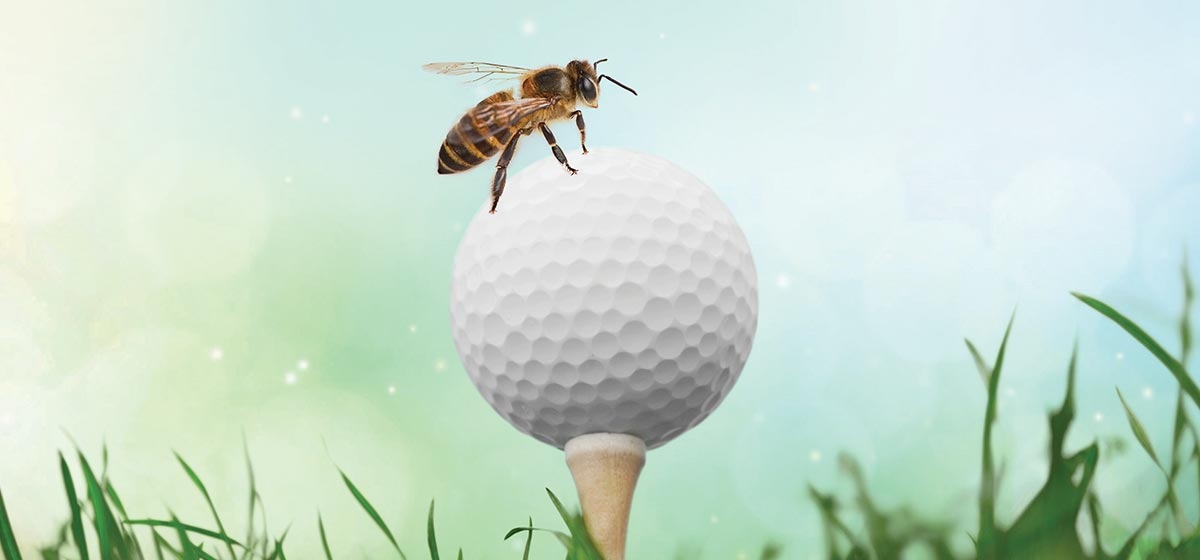A Modest Proposal

Mother Nature has a sense of humor and the soul of Monet. The change in the yard was startling. In just a week it went from being a crabgrass plantation to a breathtaking carpet of fluffy, soft-white clover, a pastel hand-delivered from the French master himself. But lawns are supposed to be neat and clean and closecropped, and so it was time to mow.
But bees—hundreds of them, maybe thousands—had come from somewhere and found the yard, and were frantically wrestling the fuzzy little flowers, getting knee-deep in pollen. The bees were in their life-giving element. Who could possibly start a mower now? Who could possibly attack the lawn? It would be like destroying a playground.
The clover would stay for as long as the bees wanted it. Would that hurt anything? I asked an entomologist at the Carnegie. “Maybe your neighbors’ feelings,” he said. “How they feel about your lawn looking like that.”
* * *
Scientists are concerned—and baffled. Something’s been killing honey bees all over the world for about 10 years. Commercial beekeepers, who truck great numbers of bees to pollinate huge farms all over the country, have noticed it most. Hackenberg Apiaries in Lewisburg, Union County, reported dropping from 1,700 hives to under 300 at one point. Adee Honey Farms, of South Dakota, the country’s biggest, dropped from 90,000 hives to 40,000. The Bee Informed Partnership (beeinformed.org), a nonprofit academicindustrial coalition, reported that from April 2015 to March 2016, U.S. beekeepers lost 44 percent of their colonies, and that Pennsylvania alone lost 41 percent. Wild bee colonies are also shrinking.
Alongside these facts, place this one: Bees pollinate about 75 percent of the nation’s vegetables, fruits and nuts.
In all of that, there’s an equation that is more or less chilling.
No specific villain has been found, but there are some strong suspects. Chief among them are the relatively new neonicotinoid pesticides, welcomed as a blessing but now causing serious doubts; a virus that attacks bees, and the loss of bee habitat.
* * *
To borrow from an overworked movie line, “If you build it, they will come.”
There are some 15,000 golf courses in the United States—private country clubs, public, municipal. It’s safe to say that all of them have some scrubby ground, probably around the perimeter, unneeded, unused and left to grow wild.
With very little initial effort and expense and with little attention afterward, this ground could help save the nation’s bees and, perhaps, us.
Plant wildflowers. Bees love wildflowers.
“You can’t replace bees with a microrobot or an iPod or an app or anything. We are completely dependent on bugs to retain the human race.”
—Sam Droege, U.S. Geological Survey bee expert, National Geographic Magazine, May 19, 2015
The idea of bees and golf struck me last June when I returned from a week of covering the U.S. Open at Oakmont Country Club and was stunned to find our yard covered with clover and bees, neither of which we had seen before.
I emailed the outline for a simple program to help restore bees to Mike Davis, executive director and CEO of the U.S. Golf Association—the organization that, in effect, runs golf. He answered fast: “I love it!” The matter currently awaits procedural study with the USGA’s Green Section, the department that deals with things that grow.
Meanwhile, the Western Pennsylvania Golf Association (West Penn), one of about 75 regional USGA associations throughout the country, has adopted the program.
“I emailed the outline for a simple program to help restore bees to Mike Davis, executive director and CEO of the U.S. Golf Association— the organization that, in effect, runs golf. He answered fast: ‘I love it!’ ”
“The land is available, so with a little effort, this will be beneficial to the country and to golf,” said Mark Caliendo, of Montour Heights Country Club and new president of West Penn, which has some 135 member clubs. “We will support the program, and we will certainly encourage our clubs.”
Caliendo picked up where Ron Moehler, of Chartiers Country Club, left off when he was the West Penn president in 2016 and opened the door to the bee program in initial chats. Said West Penn Executive Director Terry Teasdale: “We’re happy to be part of it. I’m so pleased that golf can take a role in this. It’s a win-win situation.”
When it comes to bees and golf courses, the overriding question would be the danger of bee stings—and especially for people who are allergic to them.
There are no guarantees here or anywhere else. But visitors to golf courses generally are exposed to bees the instant they step out of their cars. Most golf courses have flower plots and the like at the entrance to the clubhouse and around it, and also out on the course. Flowering trees also attract bees. The habitats would probably be out on the perimeter of the property, far beyond any of these.
The program is completely voluntary and is the simplest imaginable:
-
- There is no cost to the West Penn Golf Association for adopting the program, and no obligation beyond encouraging member clubs to participate.
- No member club is under any obligation under the program. There are no assessments, dues, reports, etc.
- Clubs, of course, will choose how much of their property to devote to a habitat, and its location.
- Some wildflowers are specific to certain areas of the country, so clubs should be careful in buying seeds.
- Check the Internet for directions on how to plant the wildflowers. In the simplest terms: Clear the land, till it lightly, mix the seeds with sand, and spread. Tamp the sand gently. Stand back and let nature take its course.
- The cost of creating a habitat would obviously depend on its size. The bigger the habitat, the more of everything would be needed—time, work, seed. Chats with a number of golf course superintendents put a general figure of perhaps $300–$400 at most.
- Clubs that want to go beyond the habitats and install bee hives will pay more—the cost of the hives, and then the cost of a beekeeper for the periodic visits.
* * *
Augusta National has the azaleas and the towering pines, Pebble Beach the Pacific surf, St. Andrews the howling winds and the history. Shannopin Country Club, at Ben Avon Heights about nine miles northwest of Downtown, may have the most important of all—bee hives.
I became aware of this about six months after proposing my habitat program to the golf associations. Shannopin has four living, working hives, and as off-putting as it may seem, they are in the interior of the course. Two hives are about 25 yards beyond the 10th green—within easy reach of the overhit approaches—and two others are 25 yards from the 18th tee.
The hives are not sitting in ornamental, cultivated flower beds, but in patches of wildflowers, right near where people are playing golf.
(For the golfer: These are designated as “Environmentally sensitive areas.” People are to keep out. It’s a one-shot penalty and a drop for a ball hit into the wildflowers.)
As for the behavior of the bees—stinging, mostly, there have been no complaints and no problems, said Shannopin president Robert Noethiger. “The bees are so docile,” he said. “They just go about their business as though we’re not even there.”
Shannopin came to its bees almost as an afterthought in 2011. They were the outgrowth of a little beautification project out on the course. All told, about a half-acre.
“We cut down some scraggly pines and cleared out some stuff, and then did a little light tilling to plant grass,” said Superintendent Eric Wygant. “A couple hours’ work. But grass wouldn’t grow. Poor soil conditions. So some members said ‘How about wildflowers, just for the beauty?’ The flowers grew, and then they said, why not some bees to help with the pollination? And that’s how we got the bees. And, of course, when you get bees, you need a beekeeper.”
A beekeeper can be hired to pay the periodic visits, but Wygant took the training and became the beekeeper himself. The cost of the hives and the beekeeper kit was about $600, he said. Two members of his grounds staff also have become beekeepers. There is some weeding occasionally. Upkeep is minimal.
“The only thing you have in it is time,” said Wygant.
The golfers get the beauty, the pastry chefs get the honey, and the bees get a life.





